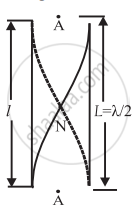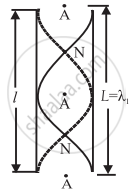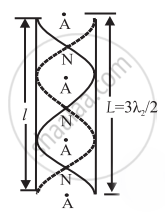Advertisements
Advertisements
प्रश्न
With a neat labelled diagram, show that all harmonics are present in an air column contained in a pipe open at both the ends. Define end correction.
उत्तर
Consider 'l' length cylindrical pipe that is open at both ends. In a cylindrical open pipe, sound waves are sent down the air column and reflected at the open ends without changing phase. Under the right circumstances, interference between incident and reflected waves creates stationary waves in the air column.
Stationary waves are produced due to the superposition of two identical simple harmonic progressive waves traveling through the same part of the medium in opposite direction. In the case of pipe open at both ends, the air molecules near the open end are free to vibrate, hence they vibrate with maximum amplitude. Therefore each open end becomes an antinode.
Taking into account the end correction e at each of the open ends, the resonating length of the air column is L = I + 2e.
Let v be the speed of sound in air. The simplest mode of vibration is the fundamental mode of vibration. The fundamental tone or mode of vibrations of the air column open at both ends is as shown below figure. There are two antinodes at two open ends and one node between them.

The distance between two consecutive antinodes is `λ/2`, where λ is the wavelength of sound. The corresponding wavelength λ and the fundamental frequency n are
λ = 2L and n = `v/λ = v/(2L) = v/(2(l + 2e))` ...(1)
This is the fundamental frequency or the first harmonic. It is the lowest frequency of vibration.
The next possible mode of vibrations of the air column open at both ends is as shown in the below figure. In this case, two nodes and three antinodes are formed. If λ1 and n1 be the corresponding wavelength and frequency,

λ1 = L and n1 = `v/(λ_1) = v/(L) = v/(l + 2e) = 2n` ...(2)
This is the frequency of the second harmonic or first overtone.
In the next of vibrations of the air column open at both ends as shown in the below figure, In this case, three nodes & four antinodes are formed. If λ2 and n2 be the corresponding wavelength & frequency

λ2 = `(2L)/3 "and" n_2 = v/(λ_2) = (3v)/(2L) = (3v)/(2(l + 2e)) = 3n` ...(3)
This is the frequency of third harmonic or second overtone.
Therefore, in general, the frequency of the pth overtone (p = l, 2, 3, ... ) is nP = (p + l)n ...(4)
i.e., the pth overtone is the (p + l)th harmonic.
Equations (1), (2) and (3) show that allowed frequencies in an air column in a pipe open at both ends are n, 2n, 3n,... Thus all harmonics are present as overtones in the modes of vibration of air column open at both ends.
APPEARS IN
संबंधित प्रश्न
The fundamental frequency of an air column in a pipe closed at one end is in unison with the third overtone of an open pipe. Calculate the ratio of lengths of their air columns
In a set, 21 turning forks are arranged in a series of decreasing frequencies. Each tuning fork produces 4 beats per second with the preceding fork. If the first fork is an octave of the last fork, find the frequencies of the first and tenth fork.
The value of end correction for an open organ pipe of radius 'r' is .........................
A) 0.3 r
B) 0.6 r
C) 0.9 r
D) 1.2 r
A pipe which is open at both ends is 47 cm long and has an inner diameter 5 cm. If the speed of sound in air is 348 m/s, calculate the fundamental frequency of air column in that pipe.
A pipe open at both ends resonates to a frequency ‘n1’ and a pipe closed at one end resonates to a frequency ‘n2’. If they are joined to form a pipe closed at one end, then the fundamental frequency will be ______.
(A) `(n_1n_2)/(2n_2+n_1)`
(B) `(2n_2n_1)/(2n_2+n_1)`
(C) `(2n_2n_1)/(n_1+n_2)`
(D) `(n_2+2n_1)/(n_1n_2)`
Two sound notes have wavelengths 83/170 m and 83/172 m in the air. These notes when sounded together produce 8 beats per second. Calculate the velocity of sound in the air and frequencies of the two notes.
Discuss different modes of vibrations in an air column of a pipe open at both the ends.
State the cause of end correction.
Find the end correction for the pipe open at both the ends in fundamental mode.
A tube open at both ends has length 47 em. Calculate the fundamental frequency of air column. (Neglect end correction. Speed of sound in air is 3.3 x 102m/s}
Draw neat labelled diagrams for modes of vibration of an air column in a pipe when it is closed at one end.
Hence derive an expression for fundamental frequency in each case.
What is meant by harmonics?
Show that only odd harmonics are present as overtones in the case of an air column vibrating in a pipe closed at one end.
Show that even as well as odd harmonics are present as overtones in the case of an air column vibrating in a pipe open at both the ends.
A wheel of moment of inertia 1 kg.m2 is rotating at a speed of 30 rad/s. Due to friction on the axis, it comes to rest in 10 minutes. Calculate the average torque of the friction.
In the law of tension, the fundamental frequency of the vibrating string is, ______
State law of tension.
State law of linear density.
What is the resonance?
How the frequency of the vibrating wire is affected if the load is fully immersed in water?
A sonometer wire of length 1 m is stretched by a weight of 10 kg. The fundamental frequency of vibration is 100 Hz. Determine the linear density of the material of the wire.
Waves produced by two vibrators in a medium have wavelength 2 m and 2.1 m respectively. When sounded together they produce 8 beats/second. Calculate wave velocity and frequencies of the vibrators.
State and verify the laws of vibrating strings using a sonometer.
Draw neat labelled diagrams for the first and second overtones of vibration of an air column in a pipe open at both ends.
